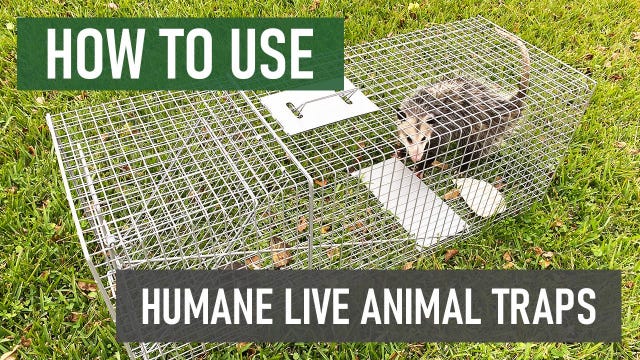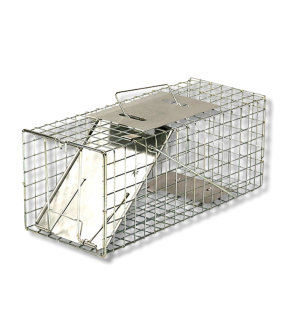Gain access to personalized product screening, the best pricing, rewards, and more!
Most Effective Products
How to Catch a Woodchuck with a Live Trap
Also known as a groundhog, a woodchuck is a rodent notorious for wreaking havoc on lawns. These animals may destroy your yard for fresh vegetables and other food. One method of removing a woodchuck from your property is using a live trap to catch and release the animal. Live trapping is a safe and effective way to keep animals away from your home.
If you want to catch a woodchuck with a live trap, read this guide for instructions and product recommendations.
Identification
Before using a live trap, you must ensure that the wild animal you are dealing with is a woodchuck. This will ensure that you are using the correct bait and strategies.

Woodchucks are generally 16.5 to 27 inches long. They have strong back legs and normally weigh between 4.4 and 13.9 pounds. They are intelligent animals who are active during the day. Their teeth grow every week, which means they constantly need to chew something. Their diet consists of berries, grass, and other vegetation. Woodchucks are burrowing animals and will create burrows for areas to sleep.
Use the image and description above to confirm that you are dealing with a woodchuck on your property.
Inspection
Once you've confirmed that your pest animal is a woodchuck, it is helpful to recognize the areas where it is most active. This is where you will place your live trap.
Where to Inspect
You want to pick areas with high woodchuck activity. These animals are most likely searching your property for food. Woodchucks are generally around fields, pastures, and areas with vegetation.
What to Look For
Because woodchucks are active during the day, damage will occur. Certain signs signal woodchuck activity, such as woodchuck tracks. These tracks will have four toes on their front feet and five on their hind feet.
Treatment
Now that you've identified your pest animal as a woodchuck and noted areas where it is most active, you can use your live trap. Be sure to wear gloves when handling the trap to prevent leaving your scent. If a woodchuck picks up a human scent on the trap, it will avoid it, making it ineffective.
Step 1: Remove Food Sources
You want the woodchuck to enter the live trap with the help of bait. Because of this, competing food sources need to be removed. Keep your trash sealed in trash bags and stored in trash bins with a lid to keep it closed. Any pet food or water bowls should be placed inside as soon as possible.
Step 2: Place the Trap

By now, you should have taken note of areas with high woodchuck activity. These areas are where you will put your trap. Be sure to place your trap on an even surface. A woodchuck might push or knock over the trap to reach the bait inside. Place a brick or weight on top of the trap to avoid this.
Step 3: Bait and Set the Trap

Using the proper bait will increase your chances of catching a woodchuck. These animals prefer sweet fruit such as cantaloupe or strawberries. The bait should be placed near the back of the trap. This ensures the woodchuck must step on the trigger plate to reach the food.
You will then set your trap by pushing on the door lock and lifting the door plate. Keep the door plate lifted while pulling the trigger arm forward to set it. You will know it is set when the trigger arm's hook catches the door.
Step 4: Monitor the Trap

You will need to check the traps twice a day, preferably once in the morning and once in the evening. This is when you will refill bait if needed. Checking the trap frequently may dissuade woodchucks from approaching the trap. Do not keep an animal trapped in the cage for 24 hours.
Step 5: Relocate the Woodchuck
Any non-target animals should be released immediately. Once you have captured a woodchuck in your live trap, check with your local authorities to ensure you correctly relocate the animal. Approach the trap slowly and use a gentle voice. Place a towel over the cage to avoid frightening the woodchuck. Once you have relocated far enough, carefully open the trap and release the animal. You can read more about releasing an animal from a live trap here.
Prevention
After using your live trap, you want to ensure that wild animals do not invade your property again. You can take some preventative measures to keep your area woodchuck-free.
Sanitation
An unkempt yard will attract woodchucks. Regularly maintain your area by mowing your lawn and removing weeds. Till the soil to destroy established burrows. Sweep up and dispose of debris. This will prevent woodchucks from returning in search of food.
Exclusion
If your property is near a wooded area and you have no fencing, you are more susceptible to having woodchucks and other wild animals invade your property. Consider blocking off your property with some fencing. If you install fencing, ensure it is at least 6 feet tall and 10 inches underground. This is to prevent woodchucks from climbing the fence or digging under it.
Key Takeaways
- Woodchucks are active during the day. They have brown fur and a small bushy tail. Their eyes and ears are small, but they have very large teeth growing weekly.
- Bait the live trap with sweet fruit like cantaloupes or strawberries, placing it behind the trigger plate of the trap.
- Check the trap once in the morning and once in the evening. Once a woodchuck is caught, check with your local authorities to ensure you safely and correctly release it.
- Install fencing along your property and maintain your yard to prevent woodchucks from entering again. Mow your grass regularly and pull away any weeds. Till your soil to get rid of any burrows.







